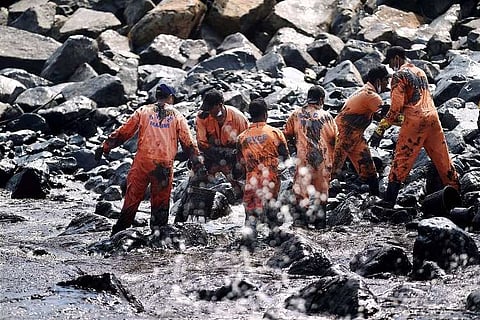

Nearly 11 months after Chennai woke up to the news of an oil spill near Ennore, the Directorate General of Shipping has pegged the loss of oil from the damaged Dawn Kanchipuram vessel to be close to 251.46 tonnes. Not only does this crucial figure come late but it is also over 200 times the amount of oil that the Kamaraj Port had initially quoted.
According to reports, an investigation team headed by Capt Ranjit Muduli, Deputy Nautical Adviser of Directorate-General of Shipping, Mumbai, has come out with a 33-page report on the Ennore oil spill.
The shipping authority has reportedly found several deviations in the application of international regulations for preventing collisions at sea, 1972 (COLREGs). It has further blamed the vessel for underestimating the quantum of leak. This has been quoted as the reason for the delay in the deployment of oil spill response equipment to full capacity by Kamarajar Port and the Indian Coast Guard.
“An initial underestimation of the extent of damage and an inadequate monitoring of the tanks’ contents subsequent to the collision, by the Dawn Kanchipuram staff, had caused the damage to Fuel Oil (Centre) Tank going unnoticed.
This was discovered only by the investigation team from MMD, Chennai. To prevent further leakage and to determine the exact amount of oil escaped into the sea, the officers of the DG Shipping decided to transfer oil and oily water mixture that was contained in various tanks and trapped in the ship structure, to shore tank. The final loss of oil into the sea is 251.46 tonnes (approx),” the report says, according to TNIE.
But environmentalists who have been studying this case closely claim that neither the port nor the Coast Guard were equipped to deal with the spill, no matter what the magnitude.
“The Kamarajar Port had no contingency plan. Their first reaction was to claim that there was no oil spill,” reminds Pooja Kumar of the Coastal Resource Centre.
“Their first reaction was not adequate even if it was 1 tonne of oil. And now this number just proves that the removal of the oil film and sludge from the surface was not enough at all. The rest of the oil would have settled on the sea bed and there are still no numbers to determine how much oil that is. How will we come up with a remediation plan without knowing?” she asks.
MT Dawn Kancheepuram had 32,000 tonnes of oil when it collided with BW Maple on January 28. In the clean-up efforts that followed this disaster, buckets were used to remove sludge and oil, which amounted to close to 200 tonnes.
Environmentalist Shwetha Narayan tells TNM that the data released by the DG Shipping is both late and inadequate.
“This is a number that should have been released hours after the spill. Now, it is merely useful for records. What we need at this point is to know the area that has been affected, how much oil is still in the sea and what steps have been taken to ensure the removal of these toxins,” says Shwetha.
Following the oil spill, people residing as far as 35 km from the site of the disaster reported seeing oil film and deposits in the sea.
“Are they monitoring the impact of this spill? Do they realise that it will affect the marine ecology and the people whose diet involves seafood?” asks Swetha.
“They have completely trivialised the oil spill by acting so late and failing to provide the right kind of information,” concludes the environmentalist.